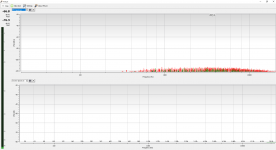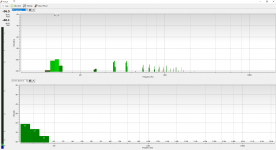Hi All,
I have a Focusrite Forte soundcard and would like to measure the background hiss / noise level from some power amps connected to a prepro. I'm fault finding a potential ground loop / noise issue and a visual representation would make changes much easier to track.
Is it possible to wire 2 power amp channels to the Focusrite line in or mic inputs as long as I keep the volume low? If so, how?
I have a Focusrite Forte soundcard and would like to measure the background hiss / noise level from some power amps connected to a prepro. I'm fault finding a potential ground loop / noise issue and a visual representation would make changes much easier to track.
Is it possible to wire 2 power amp channels to the Focusrite line in or mic inputs as long as I keep the volume low? If so, how?
A speaker out to balanced mic in adapter is given here:
150 Hz / 250 Hz / 350 Hz noise in linear PSU
The resistor values given should cover most pre/power combos easily (they'll give about +2 dBu for 200 W / 8 ohm level, I think the Forte can take substantially more), although measuring power amps by themselves may require substantially reducing attenuation. Attenuator output impedance could also be dropped a factor 2-3 still, I think there's about 3 dB lower noise performance in it still.
I would not recommend not having at least a few hundred ohms for R1 + R3 in there, but if you really insisted you could obviously go R1 = R3 = short, R2 = R4 = open.
150 Hz / 250 Hz / 350 Hz noise in linear PSU
The resistor values given should cover most pre/power combos easily (they'll give about +2 dBu for 200 W / 8 ohm level, I think the Forte can take substantially more), although measuring power amps by themselves may require substantially reducing attenuation. Attenuator output impedance could also be dropped a factor 2-3 still, I think there's about 3 dB lower noise performance in it still.
I would not recommend not having at least a few hundred ohms for R1 + R3 in there, but if you really insisted you could obviously go R1 = R3 = short, R2 = R4 = open.
Last edited:
Thank you, this is really helpful.
The spec for the Forte line input I'm using is:
Maximum Input Level for 0 dBFS: +20 ± 0.5 dBu at minimum gain; pad off
With the gain turned all the way down and the pad off the level was right for measuring the full 8V output of my prepro using RMAA. So I think it is ok with up to +30dBu as long as I enable the 10dB pads.
Forgive me if I misunderstand but are you saying I could wire the speaker outs directly to the positive and negative of the line level input?
The spec for the Forte line input I'm using is:
Maximum Input Level for 0 dBFS: +20 ± 0.5 dBu at minimum gain; pad off
With the gain turned all the way down and the pad off the level was right for measuring the full 8V output of my prepro using RMAA. So I think it is ok with up to +30dBu as long as I enable the 10dB pads.
I would not recommend not having at least a few hundred ohms for R1 + R3 in there, but if you really insisted you could obviously go R1 = R3 = short, R2 = R4 = open.
Forgive me if I misunderstand but are you saying I could wire the speaker outs directly to the positive and negative of the line level input?
I would not recommend not having at least a few hundred ohms for R1 + R3 in there, but if you really insisted you could obviously go R1 = R3 = short, R2 = R4 = open.
I just tried this with a spare fairly cheap power amp and it seems to work but I am seeing some fairly odd behaviour which I think is ground related but I wondered if anyone might know what this is.
I set the Forte line inputs to 0gain (2V max) and connected one line input directly to the speaker outputs of an Audac EPA254 poweramp.
With nothing connected (Or the power amp unplugged from power) the noise floor is about -130dB on the FFT. With the power amp on with max gain set but no input connected the noise rises to about -112dB (Which seems reasonable, see Image 1).
However if I power off the power amp at the plug switch; noise increases significantly to about -98dB which I dont understand (See Image 2). This is with the laptop running on battery, if I plug in the charger noise goes ballistic to approx -20dB if the power amp is off which I assume is a ground loop
Attachments
From what I have seen, a typical computer will have a lot of noise itself, not something I would pick to use for instrumentation/measurement. Maybe ok depending on the particular amp.
Maybe with a separate power supply?
Maybe with a separate power supply?
This is not entirely surprising. The measurement system and DUT really should not be floating relative to each other, as common-mode input limits may easily be exceeded - normally the DUT input connection takes care of that part. Things should calm down once you either plug one of the Forte's outputs into the amplifier input or give the Forte an earth connection. Looks like there may be some common mode to differential mode conversion going on somewhere.However if I power off the power amp at the plug switch; noise increases significantly to about -98dB which I dont understand (See Image 2). This is with the laptop running on battery, if I plug in the charger noise goes ballistic to approx -20dB if the power amp is off which I assume is a ground loop
It goes without saying that the wiring should conform to the usual construction guidelines for balanced cabling - i.e. keep things as closely together as possible, preferably twisted.
Note: It is to be determined experimentally whether the line-in or the mic in (with correspondingly higher attenuation) gives better performance. Line-ins may only have moderately high CMRR.
Last edited:
This is not entirely surprising. The measurement system and DUT really should not be floating relative to each other, as common-mode input limits may easily be exceeded - normally the DUT input connection takes care of that part. Things should calm down once you either plug one of the Forte's outputs into the amplifier input or give the Forte an earth connection. Looks like there may be some common mode to differential mode conversion going on somewhere.
It goes without saying that the wiring should conform to the usual construction guidelines for balanced cabling - i.e. keep things as closely together as possible, preferably twisted.
Note: It is to be determined experimentally whether the line-in or the mic in (with correspondingly higher attenuation) gives better performance. Line-ins may only have moderately high CMRR.
Big thank you for the response. I eventually measured the Hypex based amp which showed lower noise and much flatter noise across the frequencies but it looks like you are right about grounding the Focusrite as I can see similar 50hz multiples when I measure the XLR outputs of the prepro with the Focusrite.
The prepro does not have XLR inputs but would it work for grounding if I connect the Focusrite TRS output to an RCA input on the prepro?
- Home
- Amplifiers
- Solid State
- Sound card to measure power amp noise floor?


